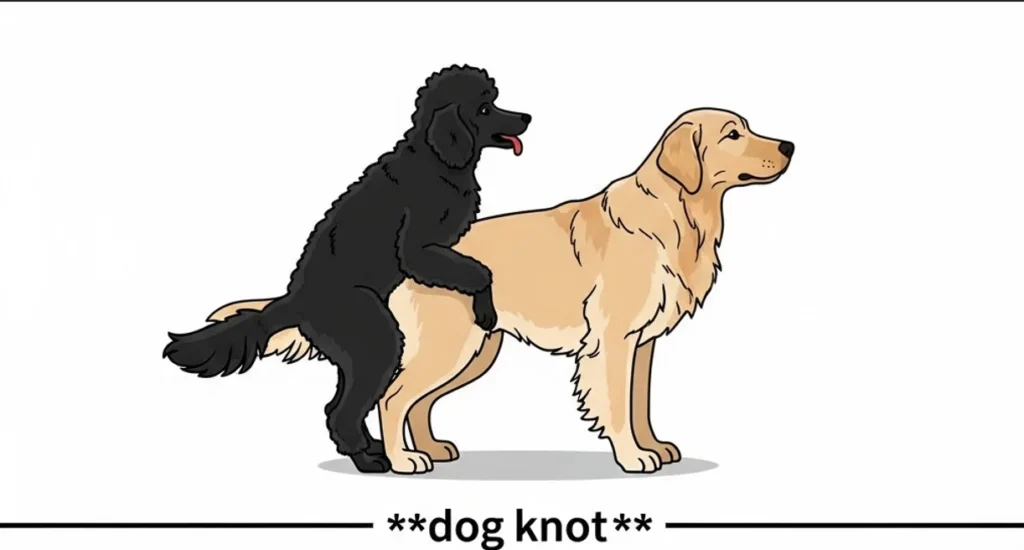
Author: DogsBlogSS Team
⚠️ Disclaimer: This article is for informational purposes only and is not a substitute for consulting a veterinarian.
dog knot
If you’ve ever heard someone mention a “dog knot” and wondered what on earth that means, you’re not alone — it’s one of those strange-sounding but entirely natural parts of canine anatomy. The “knot” isn’t a collar or a trick; it’s a biological mechanism rooted in the very design of how dogs reproduce. Understanding it can be both fascinating and reassuring, especially if you’re a dog owner or breeder. In this article, we’ll walk through what exactly the “dog knot” (also called the bulbus glandis) is, why it happens, how long it lasts, and what you should do if you ever witness it in real life.
Understanding the “Knot” in Dogs
What is a dog knot (or bulb/bulbus glandis)?
According to wikipedia: The “dog knot” refers to a part of a male dog’s anatomy called the bulbus glandis. This is an erectile tissue at the base of the penis which swells dramatically when the dog is aroused. During mating, this swelling helps form a kind of natural lock—what people often call a “tie.”
According to wikipedia: Veterinary sources explain that, as the bulbus glandis engorges with blood, it becomes wider and more rigid, and the muscles inside the female’s vagina contract to grip it. In simple terms, it’s nature’s way of helping the male stay connected long enough to transfer sperm effectively.
Why do male dogs “tie” during mating?
According to wikipedia: That “tying” or “locking” during dog mating isn’t just an awkward quirk — it’s a purposeful biological adaptation. As the bulbus glandis swells, the female’s circular vaginal muscles contract around it, creating a snug grip.
According to thejit: This rare mechanism among mammals ensures that semen stays inside the female long enough to improve the chances of fertilization.
According to thejit: One practical way to think of it: imagine putting a slightly larger plug into a tight socket. As the plug expands, the socket grinds in tighter, making removal more difficult. In dogs, this “lock” means the male can’t easily pull out, and they often end up standing or sitting butt-to-butt until the swelling subsides.
Is the knot a normal part of dog anatomy?
According to wikipedia: Yes — absolutely. The bulbus glandis is a completely normal anatomical structure in male canines.
According to smallanimalclinic: It’s not a disease, injury, or abnormal tumor. In fact, veterinarians consider the tie a healthy and expected part of natural canine reproduction.
Sometimes people worry the dogs are “stuck,” but actually, they’re just locked in place by biology. Interfering with that process can be harmful — more on that later.
How long does a dog tie last?
According to petscare: This is one of the most common questions, and the answer varies. On average, a canine tie lasts 15 to 30 minutes, but it can be as short as 5 minutes or stretch up to 45 or even 60 minutes, depending on factors like breed, size, stress levels, and experience of the dogs.
According to smallanimalclinic: Veterinary clinics often note that a tie lasting up to 15–30 minutes is normal. In rare cases, if tension or anxiety is high, it could stretch longer, but that’s not the rule.
What is the purpose of the knot during canine reproduction?
So why does nature bother with this elaborate locking mechanism? There are a few key reasons:
- According to animalpha: Better sperm retention. By keeping the male inside the female longer, the tie helps ensure that more semen stays where it matters, deep in the reproductive tract.
- According to thejit: Reduced sperm competition. While the tie persists, other male dogs can’t mate with her, which decreases the chance of rival males interrupting the process.
- According to wikipedia: Stimulated ejaculation. The contractions from the female’s vaginal muscles help stimulate ejaculation of both sperm-rich fluid and, afterward, prostatic fluid.
- According to animalpha: Natural timing. The tie enables a more controlled and extended mating phase, which may increase the likelihood of successful fertilization.
In short, the “knot” isn’t just a weird trick — it plays an important role in canine reproduction.
Mating and Breeding Concerns
Now that we’ve covered the biology, let’s dive into the practical side of things — what breeders, pet owners, or anyone who’s observed a mating tie might want to know.
Do all male dogs get a knot during mating?
According to thejit: Most intact (unneutered) male dogs with normal anatomy will experience some degree of swelling in the bulbus glandis during mating, which leads to the knot.
According to animalpha: However, the exact size, firmness, and duration of the knot can vary significantly based on factors like the dog’s age, health, breed, and arousal level.
According to bpvets: It’s possible for mating to occur without a full “tie,” especially if ejaculation happens quickly. But the tie is a common and expected feature when conditions are normal.
Can a dog get pregnant without a full tie?
According to bpvets: Yes. Experts such as John S. Parker, DVM (cited in breeding literature) report that pregnancy can occur even without a full copulatory tie.
According to petvblog: The presence of the tie increases the chance of successful fertilization, but it’s not strictly necessary.
Semen is often deposited early in the mating process, so even partial mating can lead to pregnancy. But from a reproductive-efficiency standpoint, a full tie improves the odds.
What should I do if my dogs get stuck in a tie?
If your dogs are tied (i.e., locked by the knot), here’s what to do:
- According to petscare: Stay calm. Your anxiety may stress them, making things worse.
- According to petscare: Keep the area peaceful. Make sure the environment is quiet, stable, and free of disturbances.
- According to petvblog: Avoid interfering. Do not try to force them apart — pulling can cause serious injury to either dog.
- According to petscare: Ensure stable footing. Make sure the ground isn’t slippery, and that both dogs are balanced, reducing risk of falls.
- According to bpvets: Supervise but don’t micromanage. Watch quietly; don’t prod, spray water, or attempt to separate them.
According to petscare: If the tie goes on unusually long (for example, more than one hour) or if either dog appears very stressed, bleeding, or in pain, you should call a vet for guidance.
Is it safe to separate dogs during a tie?
According to bpvets: Generally, it is not safe to forcibly separate dogs during a tie. The bulbus glandis is swollen and the vaginal muscles are contracting tightly around it. Pulling them apart can damage delicate tissues in both the male and the female.
According to smallanimalclinic: Veterinary advice, echoed across professional breeding guides, strongly recommends waiting for natural separation.
According to bpvets: Even seemingly innocent “quick fixes” — like pouring water, using cold compresses, or trying to physically pry them apart — can lead to injury.
At what age do male dogs develop the ability to tie?
Male dogs typically begin to develop their reproductive anatomy (including the bulbus glandis) once they reach sexual maturity. While age can vary by breed, most male dogs will be physically capable of a tie when they come into their first heat cycle, once they are hormonally mature.
According to vet.mu.edu.iq: In more technical breeding texts, they note that bulbus glandis engorgement and the ability to tie depend on full sexual maturation, which may not occur until a dog is several months old (sometimes around or after 6–12 months, depending on breed).
Of course, just because the anatomy is present doesn’t always mean a perfect tie will happen immediately — experience, confidence, and individual variation matter.
Health and Behavioral Aspects
Understanding the knot also means understanding when things are normal — and when they might be cause for concern.
Are there any health problems associated with the dog knot?
In most cases, no — the knot itself is a normal, healthy part of a male dog’s reproductive system. However, complications can arise in rare instances or under unusual circumstances. For example:
- According to petscare: If the tie lasts an extremely long time (well beyond typical durations), that could signal an issue.
- According to petscare: If you hear excessive whining, yelping, or see bleeding, these are signs something may be wrong.
- If the dog is inexperienced or frightened, anxiety may cause unnecessary stress.
If any concerns appear, it’s wise to reach out to a vet for evaluation. Better safe than sorry.
Can the knot get stuck or injured?
According to petvblog: Yes — although it’s rare, injury can happen, particularly if one or both dogs panic or struggle excessively during the tie. Forcible separation is the most common cause of problems; tugging or prying them apart risks tearing delicate tissues in the male or female.
Also, if the mating area is unsafe (slippery or uneven), one or both dogs may fall or twist awkwardly, increasing injury risk.
What if my dog’s knot seems unusually large or swollen?
According to wikipedia: If the bulbus glandis appears more swollen than usual — especially if the dog is not mating — that may signal over-excitement or another issue. In neutered dogs, for instance, swelling can still occur simply from excitement or arousal.
But if you notice persistent swelling, discoloration, pain, or anything that seems abnormal, it’s smart to have a veterinarian check it out. Sometimes what looks like the knot could be something else, or there could be irritation or infection.
Do neutered dogs still have a knot?
According to wikipedia: Yes — neutering doesn’t remove the bulbus glandis. Even neutered male dogs can experience swelling in this area. The knot may still form to a lesser degree during sexual arousal, because the anatomical structure remains, although there’s typically no fertility involved (since the testes are removed or rendered nonfunctional).
According to reddit: Because the knot structure remains, you might sometimes see the bulbus glandis protrude or swell even in neutered dogs when they become excited.
Is the knot visible when a dog is not mating?
According to reddit: Sometimes — in certain situations. When a dog is aroused but not mating, the bulbus glandis may engorge slightly, causing two bumps or lumps at the base of the penis that some people observe.
In neutered dogs, this can be more noticeable as well. As long as it’s temporary and subsides, it’s typically nothing to worry about. But if the swelling remains, or if there is pain, discharge, or other concerning signs, it’s best to consult your vet.
Misconceptions and Additional Information
Because the dog knot is not something most people talk about openly, there are plenty of myths and misunderstandings. Let’s clear up some common ones.
Is the knot painful for dogs?
According to Environmental Research: No — under normal conditions, a tie is not painful for either dog. The process is a physiological one, not a violent force play.
According to petscare: Some vocalizations or whimpers may occur, especially in first-time breeders, but these often reflect anxiety or unfamiliar sensations rather than actual pain.
According to smallanimalclinic: Veterinarians widely agree that when the tie is natural, there’s no need for human intervention, and it’s a positive sign of successful mating.
Does the knot indicate a successful mating?
According to thejit: The presence of a tie can be a good sign — it shows the male’s anatomy is functioning, and that physical connection is happening. But a knot doesn’t guarantee pregnancy.
According to bpvets: As Dr. John S. Parker, DVM, notes in breeding literature, pregnancy can happen without a tie, because fertilization may already have occurred earlier in the mating. So, while a tie helps, it’s not a foolproof indication of success.
Are there ways to prevent or encourage the tie in breeding?
If you’re breeding dogs, here are a few expert-advised strategies to manage the tie process:
- According to petscare: Create a calm, neutral environment. Avoid loud noises, other animals, or stressful distractions.
- According to s3.amazonaws: Time breeding correctly. Many breeders synchronize mating with the female’s estrus cycle.
- According to petscare: Ensure both dogs are healthy and experienced. Younger or inexperienced dogs may struggle; familiarity and practice help.
- According to petscare: Let nature run its course. Avoid forced interventions. Forcing separation can cause harm.
According to bpvets: On the flip side, trying to prevent a tie during mating (for example, in a mismating scenario) is risky. Methods like water spraying, cold compress, or prying are strongly discouraged — they can cause injury.
What’s the difference between a knot and a swollen penis in dogs?
This is a very important distinction:
- According to wikipedia: Knot (bulbus glandis): A normal, functional swelling during mating or sexual excitement. It’s part of the reproductive process and usually subsides naturally.
- Swollen penis (pathological): This could signal other issues — infection, injury, paraphimosis (where the penis is exposed and can’t retract), or inflammation. This kind of swelling might not go away, could be painful, and often requires veterinary attention.
If you notice unusual or persistent swelling outside of mating or arousal, or if the dog seems distressed, reach out to a veterinarian right away.
Final Thoughts
The “dog knot” might sound like a strange or amusing term, but it’s a beautifully engineered part of nature’s reproductive toolkit. The bulbus glandis is not a mistake — it’s a purposeful mechanism that enhances fertility and ensures better chances of successful mating. While the process may look awkward or even alarming to someone unfamiliar with it, for dogs it’s just another day doing what comes naturally.
If you’re a pet owner or breeder and you witness a tie, the best thing you can do is stay calm, give the dogs space, and let the process unfold. Avoid interfering unless there’s a serious issue — pulling them apart or panicking could do more harm than good. And if anything seems off — swelling, bleeding, distress — don’t hesitate to involve your veterinarian.
Understanding this knot is not just about demystifying a weird-sounding fact about dogs — it’s about appreciating how evolution has shaped canine anatomy for reproductive success. By learning about it, you become a more informed and caring guardian of your four-legged friends.
please leave comment
you may like it





sources
- Bulbus glandis (Wikipedia) — https://en.wikipedia.org/wiki/Bulbus_glandis (Wikipedia)
- Canine reproduction (Wikipedia) — https://en.wikipedia.org/wiki/Canine_reproduction (Wikipedia)
- Dogs Mating Naturally – PetsCare.com Guide — https://www.petscare.com/news/post/dogs-mating-naturally-guide (Veterinary Care at Your Fingertips)
- Breeding Tie in Mating Dogs – PetVBlog — https://petvblog.com/dog-breeding-tie/ (Pet BLoG)
- Breeders Guide to Canine Reproduction (DogsNSW) — https://www.dogsnsw.org.au/media/4545/canine-reproductiondocx.pdf (dogsnsw.org.au)
- Anatomical & Histological Study of Dog Penis (Mirror of Research in Veterinary Sciences) — https://mrvsa.com/upload/article%202%20Anatomical%20and%20Histological%20Study%20of%20Dog%20Penis.pdf (MRVSA)
- Breeding, Pregnancy & Parturition – Veterian Key — https://veteriankey.com/breeding-pregnancy-and-parturition/ (Veterian Key)
- What Does a Dog Knot Feel Like? – Equineathon.com — https://equineathon.com/what-does-a-dog-knot-feel-like/ (equineathon.com)
- Dog Knotting: Understanding the Canine Tie – NEA Today — https://neatodaymobile.nea.org/news/dog-knotting-understanding-the-canine (NEA)
- What Is A Dog’s Knot – KeepingDog.com — https://keepingdog.com/what-is-a-dogs-knot/ (keepingdog.com)
- Breeding & Mating Guidelines – AKC (guide) — https://images.akc.org/pdf/breeders/resources/guide_to_breeding_your_dog.pdf

